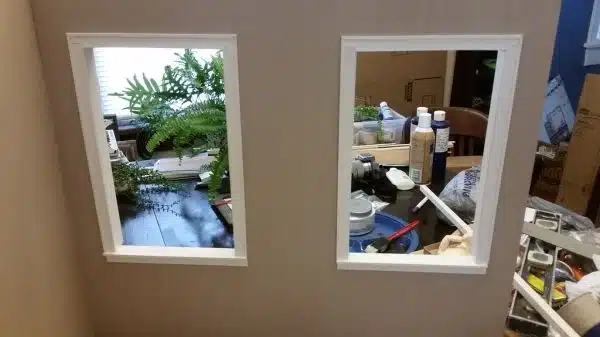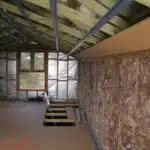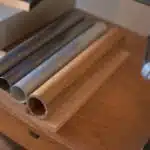Window framing is a crucial part of any construction project. A well-framed window not only enhances the aesthetics of a building but also provides proper ventilation and insulation. In this article, we will discuss the various steps involved in framing a window and provide you with expert tips to ensure that your window frame is sturdy and long-lasting.
Framing a window requires precision and attention to detail. From measuring the rough opening to cutting the lumber, installing headers, and securing the frame, every step needs to be executed with skill and accuracy. As an expert in window framing, I understand the importance of getting it right the first time. Whether you are a seasoned DIYer or a professional contractor, this article will equip you with the knowledge and skills necessary to successfully frame a window that serves its purpose while adding value to your structure.
Understanding Window Framing
A window is like the eyes of a house, allowing light and air to enter while keeping unwanted elements at bay. However, without a proper frame, even the most beautiful window can be rendered useless. Window framing is crucial for the overall structure and functionality of windows. It not only supports the window but also helps to keep it weatherproof and energy-efficient.
When considering how to frame a window, one must first understand the different types of window frame materials available in the market. The most popular options include wood, vinyl, aluminum, and fiberglass. Each material has its own set of advantages and disadvantages based on factors such as cost, durability, maintenance requirements, and aesthetics.
Window frame design is another important consideration when framing a window. The design should complement the style of the house while also providing adequate support for the glass panes. Common designs include single-hung frames, double-hung frames, casement frames, sliding frames, and picture frames. One must choose a design that meets their specific needs in terms of ventilation control, ease of operation, maintenance requirements and energy efficiency standards.
Tools And Materials Needed
Understanding the basics of window framing is crucial before attempting to frame a window. Once you have understood the foundation, it is time to start with the actual process. The first step in framing a window is to gather all the necessary tools and materials. This includes measuring tapes, saws, nails, screws, wood glue, and lumber.
Before starting the framing process, it is essential to take note of common mistakes that beginners often make. One of these mistakes is not taking accurate measurements. Measuring errors can cause problems during installation and may cause the finished product to look uneven or unprofessional. To avoid this mistake, measure twice and cut once.
Expert advice on framing windows suggests measuring the rough opening before proceeding with any other step. This will help determine how much space you have for your new window and whether it will fit into place correctly. Remember that there are different types of window frames available in the market today; therefore, it would be best to choose one that suits your needs while still maintaining high-quality standards and durability.
When installing a new window into an existing structure or building from scratch, understanding how to frame a window properly can save you time and money in the long run. However, common mistakes such as inaccurate measurements can lead to costly repairs or replacements down the line. By following expert advice and taking accurate measurements of your rough opening, you can ensure a successful installation process that will last for years to come.
Measuring The Rough Opening
Measuring the Rough Opening is a crucial step in window framing, as it sets the foundation for accurate and secure installation. Measuring accuracy is key to ensure that the window will fit perfectly in its designated space. Common mistakes when measuring include not accounting for the thickness of the window frame or failing to measure all sides of the opening.
To accurately measure the rough opening, follow these steps:
- Measure the width of the opening from side to side in three places: top, middle, and bottom. Record each measurement and use the smallest one as your final width measurement.
- Measure the height of the opening from top to bottom in three places: left, center, and right. Record each measurement and use the smallest one as your final height measurement.
- Measure the depth of the opening by measuring from inside edge to inside edge in three places: top, middle, and bottom. Record each measurement and use this as your final depth measurement.
Referencing a table can also help make this step easier for those new to window framing. This table provides a visual guide on how to accurately measure a rough opening:
| Measurement | Width | Height | Depth |
|---|---|---|---|
| 1st Reading | 34 ¾” | 58 ⅝” | 5” |
| 2nd Reading | 34 ⅞” | 58 ½” | 5″ |
| 3rd Reading | 34 ¾” | 58 ¾” | 4 7/8″ |
| Final Measurement | 34 ¾” (smallest) | 58 ½” (smallest) | 4 7/8″ |
Remember that measuring accuracy is crucial when framing windows. Taking measurements multiple times can help ensure you have accurate readings before cutting lumber to size in preparation for installation. Common mistakes can lead to improper fitting, which can cause air leaks or water damage. With these steps and a little bit of patience, you’ll be on your way to framing windows like a pro.
Cutting Lumber To Size
Like a painter selecting the perfect brush, choosing appropriate lumber is crucial when framing a window. The right choice of wood can make all the difference in the durability and appearance of your finished product. Before cutting any boards, consider the specific needs of your project, such as weather resistance or load bearing capacity.
Cutting techniques for precision are essential when framing a window. Precision is key to ensuring that all pieces fit together correctly, creating a tight seal and preventing drafts. Use a reliable saw with sharp blades to avoid jagged edges and uneven cuts. Remember to measure twice before cutting once – taking extra time at this stage will save you trouble down the line.
To begin building the sill, start by selecting a piece of lumber that fits your rough opening measurements and is suitable for outdoor use. Cut it precisely to size using your chosen cutting technique, then nail it into place on top of the foundation wall. Make sure it sits level and securely fastened before proceeding with further framing steps.
Building The Sill
Accurately measuring the sill is an essential first step in constructing a window frame. The measurements taken should ensure that the sill fits properly and securely in the frame. Once the desired measurements are taken, the sill can be cut to size. Utilizing a saw and a straight edge are the best tools for ensuring that the sill is cut accurately.
Measuring The Sill
Before building a window sill, it is crucial to measure the sill accurately. Measuring the sill is an essential step in framing a window because it determines the size and shape of the sill, which affects how well it fits into the space. To measure the sill, you need to ensure that you have a level surface since an uneven surface can lead to incorrect measurements. Therefore, before measuring, make sure that any debris or dirt on the surface is cleared.
Choosing appropriate sill material is another crucial factor when measuring for a window frame. The material used for the sill depends on various factors such as climate, budget, and desired aesthetics. Common materials used for sills include wood, vinyl, and aluminum. Wood sills are popular due to their natural appearance but require regular maintenance. Vinyl sills are low-maintenance options that are ideal for areas with extreme weather conditions. Aluminum sills are durable and suitable for commercial buildings with high traffic areas.
In conclusion, measuring the sill correctly is vital in ensuring that your window frame fits perfectly into space. It’s important to choose appropriate materials based on your preferences and needs while keeping in mind budget and environmental factors. One should also be aware of creating a level surface when measuring as it has an impact on overall accuracy of measurement. By taking these steps into consideration when building your window frame, one can ensure a successful project that will serve its purpose effectively for years to come.
Cutting The Sill
After measuring the sill accurately, the next step in building a window frame is cutting the sill. Cutting techniques vary depending on the type of material being used. For instance, wood sills can be cut using a handsaw or power saw, while vinyl and aluminum sills require special blades to avoid cracking or damaging the material. When cutting the sill, it’s essential to ensure that you have precise measurements and take into account any angles or curves in the frame.
Once you have cut the sill, it’s crucial to seal it properly to prevent water damage and air leaks. Sealing methods differ depending on the type of material used for the sill. For example, wood sills require sealing with paint or stain to protect against moisture and rotting. Vinyl sills usually come pre-sealed but may require additional caulking around edges to improve insulation. Aluminum sills typically do not require sealing as they are resistant to corrosion and weathering.
In summary, cutting the sill is an important step in building a window frame that requires precision and attention to detail. Depending on the type of material used, different cutting techniques may be necessary, and proper sealing methods should be employed afterward to protect against damage from water or air leaks. With these steps taken into consideration when building your window frame, you can ensure a functional and aesthetically pleasing result that will serve its purpose effectively for years to come.
Installing The Headers
Header installation is a crucial part of framing a window. The header acts as a support system for the window and prevents any sagging or bowing over time. It is essential to install headers correctly to ensure that they can handle the weight load of your window.
Load-bearing considerations are necessary when installing headers. Headers must be strong enough to support the weight of the wall above the window opening. If you’re not sure about the load-bearing capacity of your header, it’s best to consult with an engineer or building inspector to determine if additional structural support is required. Always use high-quality lumber for your header installation, and make sure it’s appropriate for your load-bearing needs.
When installing headers, precise measurements are crucial. Measure twice and cut once to avoid any mistakes in sizing. Use metal connectors and screws to secure the header in place firmly. Remember that headers should be level, straight, and securely fastened before moving on to placing studs alongside them. Proper installation will ensure that your window remains stable and secure for years to come.
With proper header installation complete, the next step is placing the studs alongside them. By doing this, you’ll create a sturdy framework around your window opening that will provide additional structural integrity and support for your windows over time. Let’s move on to how you can correctly place studs in our next section.
Placing The Studs
When it comes to framing a window, the placement of the studs is crucial for ensuring structural integrity. The first step in stud placement is to measure the width and height of the window opening. Once you have these measurements, you can determine where the studs should be placed.
One important thing to keep in mind when placing studs is that they should always be installed vertically. This helps to distribute weight evenly across the frame and prevents any sagging or buckling over time. Additionally, it’s important to space the studs evenly apart so that there are no gaps or uneven areas in the frame.
To help with stud placement, here are four key tips to keep in mind:
- Use a level to ensure that each stud is perfectly vertical.
- Place studs at regular intervals (usually every 16 inches).
- Double up on studs at each corner for added support.
- Install header and footer plates above and below the window opening for added stability.
With these tips in mind, you’ll be able to place your studs correctly and create a sturdy frame for your window installation. From here, you can move on to adding insulation and finishing touches before completing your project.
Adding Insulation
When it comes to insulating a framed window, there are various types of insulation to choose from. The most common types used for this purpose are fiberglass batts, spray foam insulation, and blown-in cellulose. Fiberglass batts are the easiest to install and the most cost-effective option. Spray foam insulation is more expensive but provides better air sealing and soundproofing capabilities. Blown-in cellulose is an eco-friendly option that is made from recycled materials.
The installation technique used for insulating a framed window depends on the type of insulation being used. For fiberglass batts, the insulation should be cut to fit snugly between the studs around the window frame. It’s important to wear protective gear like gloves, long sleeves, and a mask when handling fiberglass insulation. For spray foam insulation, a professional should be hired as it requires specialized equipment and expertise. Blown-in cellulose can be installed using a blower machine that sprays it into the wall cavities around the window frame.
Properly insulating your windows can lead to significant energy savings by reducing heat loss during colder months and preventing heat gain during warmer months. It also helps with noise reduction and enhances indoor comfort levels. When choosing an insulation type and installation technique, consider factors such as budget, environmental impact, level of expertise required, and desired performance benefits.
As you move forward with securing your window frame in place, it’s important to keep in mind that proper insulation plays an integral role in ensuring maximum energy efficiency and indoor comfort levels. By selecting an appropriate insulation type and installation method for your window frame needs, you’ll not only save money on your energy bills but also contribute towards making your home more eco-friendly. With these considerations in mind, let’s dive into how you can secure your window frame effectively without compromising on its structural integrity or performance capabilities.
Securing The Frame
Now that you have successfully framed your window, it is essential to ensure that it stays securely in place. Window frame anchoring is crucial in keeping your window from shifting or moving, which can cause damage and compromise its energy efficiency. Anchoring can be done using screws, bolts, or clips, depending on the type of window and framing material used. It is recommended to consult a professional if you are unsure about how to anchor your window properly.
Sealing techniques are also crucial in ensuring that your window stays secure and free from leaks and drafts. Common sealing methods include caulking and weatherstripping. Caulking involves applying a sealant around the perimeter of the frame to fill any gaps or holes between the frame and the wall. Weatherstripping involves adding a seal around movable parts of the window, such as sashes or casements, to prevent air infiltration. Both methods can significantly improve your window’s energy efficiency by reducing air leakage.
To further enhance your window’s security and performance, here are five tips to keep in mind:
- Choose high-quality materials for both framing and hardware.
- Ensure proper installation by following manufacturer instructions or consulting a professional.
- Regularly inspect for any signs of wear or damage.
- Clean and maintain your windows regularly.
- Consider using additional security measures such as locks or reinforcing bars.
As an expert in window framing, I highly recommend taking these steps to secure your newly framed windows properly. By doing so, you will not only enjoy improved energy efficiency but also increased comfort and safety inside your home.
Transition: Now that we have covered securing the frame thoroughly let us discuss some common mistakes homeowners tend to make while framing their windows.
Common Mistakes To Avoid
Common mistakes to avoid when framing a window include measuring inaccurately and using incorrect materials. These mistakes can lead to uneven and unstable window frames that may not fit properly, leading to air leaks, water damage, and other issues. One of the most common mistakes is measuring the opening of the window incorrectly, which can result in a frame that is too small or too large for the opening.
Using incorrect materials can also lead to problems with window framing. For example, if you use wood that is not properly treated or sealed, it can rot or warp over time, causing the frame to become unstable and potentially dangerous. Additionally, using materials that are not strong enough to support the weight of the window can lead to structural problems down the line.
To avoid these common mistakes when framing a window, it’s important to take accurate measurements and use high-quality materials that are appropriate for your specific project. This will ensure that your finished product is stable, secure, and able to withstand the elements. In addition to following these guidelines, it’s always a good idea to consult with an experienced professional who can offer guidance and advice as needed.
Moving forward into finishing and trim work, it’s important to keep in mind how these elements will affect the overall look and function of your framed windows. By choosing appropriate finishes like paint or stain and carefully installing trim pieces around the edges of your frames, you can create a cohesive look that enhances both the aesthetics and functionality of your windows.
Finishing And Trim Work
Ironically, one of the most common mistakes made when framing a window is forgetting to measure twice and cut once. It may seem like a basic concept, but it can save both time and money in the long run. Another mistake is not paying attention to the placement of studs, which can weaken the structure of the window frame.
Once the framing is complete, it’s time for finishing and trim work. Trim styles vary from simple to ornate and can make a significant difference in the overall appearance of the window. Color options are also essential to consider as they can complement or clash with the surrounding decor. When choosing trim and color options, it’s crucial to keep in mind the desired aesthetic and functionality of the window.
As a window framing expert, I highly recommend choosing the right type of window before even beginning the framing process. Different types of windows have different requirements for their frames, so it’s important to know what kind of window will be installed before starting on framing. Choosing energy-efficient windows can also save on heating and cooling costs in the long run. With attention to detail and careful consideration of trim styles and color options, any homeowner can achieve a beautiful finished product that will enhance both their home’s appearance and functionality.
Choosing The Right Type Of Window
When it comes to choosing the right type of window for your home or building, there are a variety of factors to consider. One of the most important decisions you’ll make is selecting the right type of window material. Some common options include wood, vinyl, aluminum, and fiberglass. Each material has its own unique advantages and disadvantages, so it’s important to carefully weigh your options before making a final decision.
Cost is also an important consideration when selecting window frames. While some materials may be more expensive upfront, they may save you money in the long run by being more energy-efficient and durable. On the other hand, less expensive materials may require more maintenance and repairs over time. It’s also worth considering any additional costs associated with installation and upkeep when making your decision.
Ultimately, the right choice for your window frame will depend on your specific needs and preferences. Consider factors such as aesthetics, durability, energy efficiency, and budget when making your decision. With careful consideration and research, you can find a high-quality window frame that meets all of your needs while staying within your budget.
As you select the ideal type of window material for your home or building, it’s essential to keep in mind ways to maintain its quality over time. Proper maintenance is key in ensuring that your windows serve their purpose for many years to come without failing or wearing out quickly. There are a number of tips and tricks to keeping up with routine maintenance on your window frames that we will explore in detail in our subsequent section about maintaining your window frame.
Maintaining Your Window Frame
While framing a window is an excellent way to spruce up your home’s look, it requires consistent maintenance to maintain its beauty. Repairing damage is one of the most effective ways to keep your window frame in good shape. If you notice any cracks or holes in the frame, patch them up with high-quality sealant as soon as possible. This will help prevent further damage from occurring and extend the life of your window frame.
Preventing rot is another critical aspect of maintaining your window frame. Moisture can easily penetrate wooden frames, causing them to rot over time. To protect against this, it’s recommended that you apply a protective coating to your wooden frames regularly. This will provide an additional layer of protection against moisture and insects that can cause decay.
By properly maintaining your window frame, you can ensure that it remains sturdy and attractive for years to come. Remember to repair any damages promptly and apply preventative measures such as protective coatings regularly. Follow these expert tips for success, and you’ll be well on your way to keeping your windows looking great!
Expert Tips For Success
When it comes to framing a window, efficiency is key. Here are some expert tips for success that will help you achieve the best possible results.
Tip 1: Measure twice, cut once. This old adage applies just as well to window framing as it does to any other DIY project. Accurate measurements are crucial for ensuring a snug fit and avoiding costly mistakes. Take the time to measure your window opening carefully before making any cuts.
Tip 2: Use the right tools for the job. Window framing requires a variety of specialized tools, including a saw, hammer, chisel, and square. Investing in high-quality tools will save you time and frustration in the long run. Be sure to keep your tools sharp and well-maintained for optimal performance.
Tip 3: Avoid common pitfalls like uneven cuts or over-tightening screws. These mistakes can compromise the structural integrity of your frame and lead to problems down the line. Take your time and work methodically, double-checking your work as you go.
By following these expert tips for efficiency and avoiding common pitfalls, you’ll be well on your way to creating a sturdy, beautiful window frame that will stand the test of time. However, even with careful planning and execution, sometimes issues do arise during the process of framing windows. In the next section, we’ll explore some troubleshooting techniques for dealing with common problems that may crop up during installation.
Troubleshooting Common Issues
When framing a window, there are many common issues that can arise. One of these issues is fixing gaps. If the gap between the frame and the wall is too large, it can cause air leaks and reduce energy efficiency. To fix this issue, use foam insulation or caulk to seal any gaps. Make sure to fill in all areas where air could potentially escape.
Another common issue when framing a window is dealing with uneven walls. Uneven walls can cause the frame to not fit properly, leaving gaps between the frame and the wall. To solve this problem, shim the frame until it is level and flush with the wall. Use a level to ensure that everything is straight and even before securing the frame into place.
It is important to address these common issues when framing a window to ensure that your installation is secure, efficient, and long-lasting. By taking care of any gaps or unevenness early on in the process, you can prevent future problems from occurring down the line. Remember to always take measurements carefully and double-check your work before moving onto the next step.
| Issue | Solution |
|---|---|
| Fixing Gaps | Use foam insulation or caulk to seal gaps |
| Dealing with Uneven Walls | Shim the frame until it is level and flush with wall |
Conclusion
Window framing is an essential part of building and renovating homes. As a window framing expert, it is crucial to understand the process of measuring and cutting lumber, building the sill, choosing the right type of window, and maintaining your frame. Ensuring that each step is done correctly will lead to a successful project.
When measuring the rough opening, accuracy is key. It is important to measure twice to avoid mistakes. Cutting lumber to size requires precision and attention to detail. Building the sill involves proper placement and anchoring to prevent water damage or leaks. Choosing the right type of window involves considering factors such as energy efficiency, durability, and aesthetic appeal. Finally, maintaining your frame includes regular cleaning and inspection.
In conclusion, window framing may seem like a daunting task for some, but with the right tools and knowledge, it can be done successfully. As with any project, taking the time to understand each step thoroughly ensures that you will have a strong and durable frame that will last for years to come. Remember that “measure twice, cut once” is not only a figure of speech but a crucial rule in window framing. With patience and attention to detail, even those new to DIY projects can become experts in window framing.
Image Credits
- “Room Box Windows Framed” by ❤ ResinMuse ❤ (featured)





























